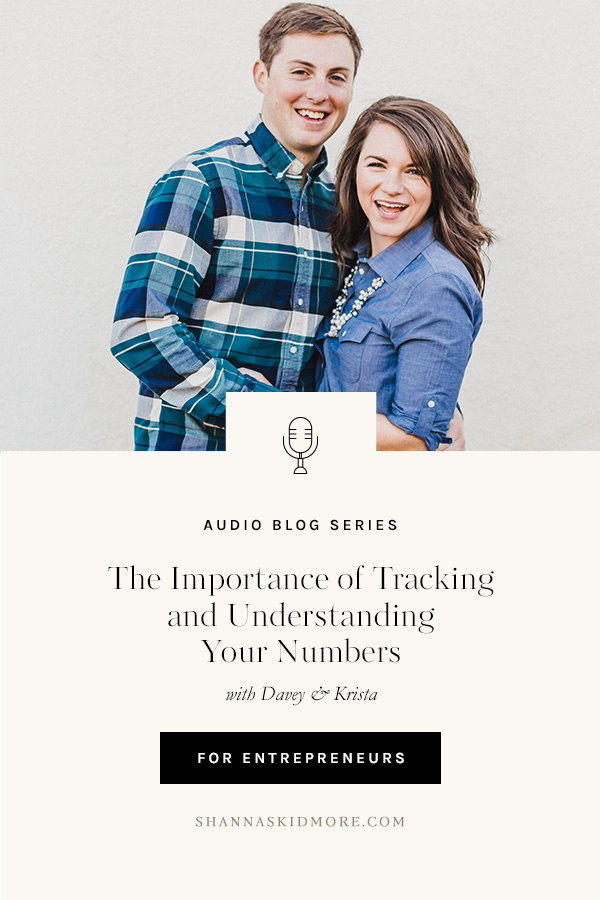Keep Reading
The Importance of Tracking and Understanding Your Numbers
Welcome to “The Best Thing I’ve Learned About Money” audio blog series. This is where you’ll hear from fellow creative entrepreneurs and mentors all about one specific topic: MONEY! Today we are so excited to introduce you to our featured guests, Davey and Krista! Hey friends! We’re Davey and Krista, brand strategists and designers who […]

Paragraph
Welcome to “The Best Thing I’ve Learned About Money” audio blog series. This is where you’ll hear from fellow creative entrepreneurs and mentors all about one specific topic: MONEY!
Today we are so excited to introduce you to our featured guests, Davey and Krista!

Hey friends! We’re Davey and Krista, brand strategists and designers who specialize in helping businesses create brands and websites that are beautiful, compelling, and encourage action.
After building a successful photography business and launching the Rising Tide Society—one of the largest communities for creatives—we decided to make helping creatives run better businesses our full-time gig.
We believe in chasing hard after an intentional life—one that includes fulfilling work, palm trees and blue skies, quality time with our son, Jack, and, of course, wine and pizza.
And today, we’re excited to be sharing with you the best thing we’ve learned about money in hopes to encourage you about the importance of tracking and understanding your numbers.
Let’s dive in!
The Importance of Tracking and Understanding Your Numbers
We’ve learned a lot about money, having started and run several businesses over the past 10 years.
These businesses include brand and website design, photography, companies started with friends, partnerships with San Francisco tech companies, courses, online shops, and other successful endeavors.
Regardless of the business, one of the most important lessons we’ve learned is to know and understand your numbers.
Knowing and understanding your numbers:
1)
Provides confidence, and eliminates a lot of the fear and anxiety around business
2)
Indicates what’s working and what’s not
3)
Provides a roadmap for growth
We should preface this by saying neither of us have formal degrees in business, finance, or statistics. Krista studied graphic design in college and, while she can identify Baskerville and Adobe Caslon Pro in an instant, everything she’s learned about bookkeeping has been through trial and error. Davey’s degree in Theological Studies hasn’t helped much on this front, either.
We mention that just so everyone knows none of this requires special training, and we’re able to do all of this with free or inexpensive tools.
What Are Your ‘Numbers’?
Shanna provides a great resource about the specific numbers you need to track as a creative business owner.
For us these include total sales, total expenses, total profit, and being able to accurately attribute where our sales are coming from.
It starts with staying on top of our bookkeeping. This was originally Davey’s task, but we found out pretty quickly that Krista’s personality was better suited for it.
It doesn’t matter too much who does it, but that it’s done. If you find that you keep putting off that task (until the end of the year when it overwhelms you), then it might be best to outsource it.
Wave Apps is a free bookkeeping tool that allows us to track, organize, and label our business transactions. We can then quickly run reports to see our total sales, expenses, and profit.
While knowing and understanding your numbers starts with bookkeeping, it goes beyond it, too. We use Google Analytics to help us understand where our online sales come from, and a simple Google spreadsheet to help us keep track of inquiries.
Our contact form includes the question, ‘How did you hear about us?’ so that we can understand what marketing channels are performing.
In general it comes down to diligently tracking your numbers. The more data that you have, the more informed decisions you can make in your business.
Why Knowing and Understanding Our Numbers Is Important
All of this might sound complicated, but it’s really not. Like we mentioned, we’re not data scientists. Really, we’re just trying to understand exactly where our money is coming from and where it’s going so we can make educated decisions in our business and life.
Understanding Our Numbers Gives Us Confidence
We know the minimum number we need to bring in each month to cover expenses, salaries, and taxes. As a result, we have a clear idea of how many clients we need to bring in each month to stay whole.
We’re confident in what’s happening within the business because there’s no confusion or uncertainty about what we need to do to remain financially healthy.
If, for example, it’s the middle of the month and our numbers are looking a little leaner than normal, we’ll chat as a team about ways to increase inquiries, push client projects forward, bump up a new product launch, or ramp up our content marketing.
Regardless of how things may seem on a day-to-day basis, keeping up with our numbers helps us know exactly how things are going.
We Know What to Expect and Better Understand the Seasonality in Our Business
We chat with a lot of creatives, and we often hear things like, “I feel like inquiries have been slow this month” or, “I think I usually have more work booked by this time of the year.”
But the easiest way to know whether or not it’s truly a slow month is to be able to compare it to the same time the previous year. Is this December different than usual? Or is this December exactly like last December?
Diligently keeping records helps us plan for the year and prepare for the seasonality in our business. It also lets us know whether we actually have something to worry about or not.
We work with a lot of wedding professionals, who tend to be busier between late April through November. Inquiries typically drop in a month like July where people are either on family vacation or trying to keep up with their busy season.
And we know this because we keep track of our inquiries.
July, then, is usually a pretty good month for us to plan our own vacation or work on internal projects that we’ll launch later in the year.
Understanding the seasonality in our business has helped us become more proactive vs. reactive.
In our current business, we know that March has typically been a slower month for custom work. Since we know that, we have planned other initiatives that have ended up transforming one of our typically slower months into one of our better months.
It Tells Us What’s Working… and What’s Not.
We want to know—as definitively as possible—how much return we earn on each of our marketing efforts.
No one wants to spend money on things that don’t work, right?
Of course some things are easier to track than others, but everything can be tracked on some level.
When we were wedding photographers, we faced decisions like whether we should invest in listings in places like WeddingWire, the Knot, or Style Me Pretty. One year we decided to invest to be part of Style Me Pretty’s Little Black Book, which is a more curated vendor list where one has to apply for acceptance.
The outcome? Very few inquiries, no additional bookings, but our work was more likely to be published by Style Me Pretty. While we were grateful for the additional social proof of SMP’s Little Black Book status and the SEO value from being published there, we decided not to renew.
If you’re advertising in a printed or digital publication, make sure you add a “How did you hear about us?” question on your contact form. If no one ever writes that publication name in your form field, that’s a pretty good indication that that method of advertising isn’t working. If you skip this step you’ll be left guessing whether or not it worked.
When you’re potentially spending thousands of dollars on an advertising campaign, you want to know whether it worked.
Some marketing ventures take several months to see a return on investment while others will have a more immediate return. And likewise, some provide a very tangible return on investment, while other initiatives might not.
Facebook ads, for example, is a channel that’s easy to measure return, and—for us—we can generally expect returns in the short term.
Provided it’s set up correctly, it’s easy to see whether or not our ads are resulting in conversions. Keeping a close eye on numbers allows us to scale ads that are working, tweak ads that are struggling, and stop ads that just aren’t working.
Our Pinterest channel, however, is somewhere we invest but have a harder time understanding exactly how many people convert into sales. We’ve decided that for this channel, specifically, our focus is increasing website traffic and lead generation.
Whatever it is—whether it’s marketing or hiring, a collaboration, or another initiative—we want to know whether it’s working or not, which means there needs to be an outcome and a way to measure that outcome.
But here’s the point…
Having a clear outcome and a way to measure that outcome is critical to understanding what’s working and how to strategically move your business forward.
How to Get Started
As we mentioned, we’re not data scientists. It actually requires very few tools for us to track what we’ve mentioned above.
In general, we use:
- Wave Apps: A ‘free-mium’ online bookkeeping solution comparable to QuickBooks.
- Google Analytics: Also free and relatively easy to set-up on a website.
- Inquiry Spreadsheet: It’s just a simple Google Sheet we created and that you can access at the end of this blog post.
There are a few other tools we use that are specific to our business such as the software we use for our online shop checkout. But the three we mentioned above are free and some of our most-used tracking tools.
The important part, we’ve found, is to get started.
We know there’s always room for improvement in the way we collect and interpret data. But if we never got started, we would have never gotten to where we are now.
And if you need help, consider outsourcing these tasks to a professional or investing in one of Shanna’s programs.
Tracking and understanding your numbers is like turning on the lights in a large house you’ve never been to before. Sure, you don’t know what’s around every corner—but you have a much better idea than if you keep the lights off.
YOUR TURN!
Thank you so much for tuning in to this week’s “the best thing I’ve learned about money” series.
In the comments below, tell us what’s most important to you in getting started?! And if you’re up for it, we would love to hear the best thing you’ve learned about money, too!

May 9, 2019
Previous Post:
Next Post:
And if you found this helpful, share with your friends!